- Home
- About
- Map
- Trips
- Bringing Boat West
- Migration West
- Solo Motorcycle Ride
- Final Family XC Trip
- Colorado Rockies
- Graduates' XC Trip
- Yosemite & Nevada
- Colorado & Utah
- Best of Utah
- Southern Loop
- Pacific Northwest
- Northern Loop
- Los Angeles to NYC
- East Coast Trips
- Martha's Vineyard
- 1 Week in Quebec
- Southeast Coast
- NH Backpacking
- Martha's Vineyard
- Canadian Maritimes
- Ocracoke Island
- Edisto Island
- First Landing '02
- Hunting Island '02
- Stowe in Winter
- Hunting Island '01
- Lake Placid
- Chesapeake
- Provincetown
- Hunting Island '00
- Acadia in Winter
- Boston Suburbs
- Niagara Falls
- First Landing '99
- Cape Hatteras
- West Coast Trips
- Burning Man
- Utah Off-Roading
- Maui
- Mojave 4WD Course
- Colorado River Rafting
- Bishop & Death Valley
- Kauai
- Yosemite Fall
- Utah Off-Road
- Lost Coast
- Yosemite Valley
- Arizona and New Mexico
- Pescadero & Capitola
- Bishop & Death Valley
- San Diego, Anza Borrego, Joshua Tree
- Carmel
- Death Valley in Fall
- Yosemite in the Fall
- Pacific Northwest
- Utah Off-Roading
- Southern CA Deserts
- Yosemite & Covid
- Lake Powell Covid
- Eastern Sierra & Covid
- Bishop & Death Valley
- Central & SE Oregon
- Mojave Road
- Eastern Sierra
- Trinity Alps
- Tuolumne Meadows
- Lake Powell Boating
- Eastern Sierra
- Yosemite Winter
- Hawaii
- 4WD Eastern Sierra
- 4WD Death Valley +
- Southern CA Deserts
- Christmas in Tahoe
- Yosemite & Pinnacles
- Totality
- Yosemite & Sierra
- Yosemite Christmas
- Yosemite, San Diego
- Yosemite & North CA
- Seattle to Sierra
- Southwest Deserts
- Yosemite & Sierra
- Pacific Northwest
- Yosemite & South CA
- Pacific Northwest
- Northern California
- Southern Alaska
- Vancouver Island
- International Trips
- Index
- Tips
- Books
- Photos/Videos
- Search
- Contact
Galapagos - Isabela Island (Day 3), Ecuador
Wednesday, March 22, 2023 - 7:15am by Lolo
0 miles and 0 hours from our last stop - 1 night stay
Travelogue
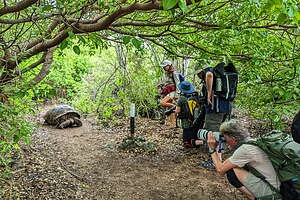 Our first Galapagos Giant TortoiseThis was our third and final day anchoring off of Isabella Island. It’s the largest of all the islands in the Galapagos so there was lots to explore.
Our first Galapagos Giant TortoiseThis was our third and final day anchoring off of Isabella Island. It’s the largest of all the islands in the Galapagos so there was lots to explore.
We started our day, like most others, with a panga ride to a shore landing to hike and meet the critters that inhabit that area. Every day we thought we couldn’t possibly see something new, yet everyday we did.
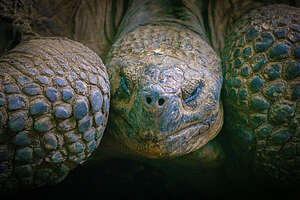 Galapagos Giant TortoiseOne of the first things we saw after our wet landing was the skull of a whale.
Galapagos Giant TortoiseOne of the first things we saw after our wet landing was the skull of a whale.
Continuing inland on a trail, we had our first encounter with a Galapagos giant tortoise, who was blocking our path.
After a photo shoot, where this tortoise got as much attention as a movie star on an Oscars red carpet walk, we tiptoed around him. He really could have cared less about us.
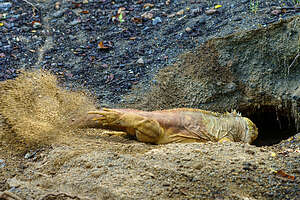 Land Iguana digging his burrowThese creatures are the world’s largest tortoises, weighing up to 500 pounds and growing to 5 feet in length. They males are significantly bigger than the females. They can live to be 100 years or more.
Land Iguana digging his burrowThese creatures are the world’s largest tortoises, weighing up to 500 pounds and growing to 5 feet in length. They males are significantly bigger than the females. They can live to be 100 years or more.
Of all the wildlife, it is the giant tortoise that most symbolizes the Galapagos Islands. In fact, Galapagos means “tortoise” and it is his face that appears on the official insignia of the islands.
Much more gravitas than calling the archipelago “Booby” or “Sally Lightfoot.”
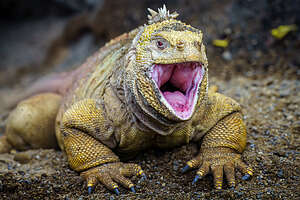 Land Iguana being a bit defensiveThere are 12 different subspecies of giant tortoises in the Galapagos. Their total population is approximately 15,000. Basically, their carapaces (shells) come in two shapes: dome-shelled, like the ones we met today, or saddle-backed, which we would meet later on Santa Cruz Island.
Land Iguana being a bit defensiveThere are 12 different subspecies of giant tortoises in the Galapagos. Their total population is approximately 15,000. Basically, their carapaces (shells) come in two shapes: dome-shelled, like the ones we met today, or saddle-backed, which we would meet later on Santa Cruz Island.
Although they might look scary, they, like iguanas, are herbivores. They are known for their ability to fast for long periods of time, which was almost their downfall, as buccaneers and whalers would carry them off to their ships and keep them in the ship’s hold without food or water, until they became fresh food for them.
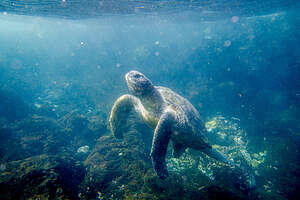 Snorkeling with the sea turtlesNext we came across a land iguana digging away at the ground, kicking sand and dirt up behind him. We had seen plenty of land iguanas already on the trip, but never this type of behavior. We learned that they are burrowing animals, and the shallow tunnels they dig out provide shelter, shade, and a nesting place for their hatchlings. The quality of his burrow is also a draw for the ladies, so he works very hard at making a nice home
Snorkeling with the sea turtlesNext we came across a land iguana digging away at the ground, kicking sand and dirt up behind him. We had seen plenty of land iguanas already on the trip, but never this type of behavior. We learned that they are burrowing animals, and the shallow tunnels they dig out provide shelter, shade, and a nesting place for their hatchlings. The quality of his burrow is also a draw for the ladies, so he works very hard at making a nice home
My favorite photo of a land iguana though was one where he was opening his mouth wide enough for us to see his tongue and tonsils (if he had tonsils).
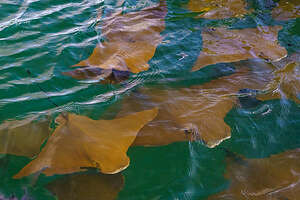 Cow-Nosed RaysI later researched why he might be doing this, and found that it is generally a sign of aggression or defensiveness, which made sense, because he might not have appreciated us getting too close to his burrow.
Cow-Nosed RaysI later researched why he might be doing this, and found that it is generally a sign of aggression or defensiveness, which made sense, because he might not have appreciated us getting too close to his burrow.
The article further went on to say that “it’s best to give your iguana plenty of space and allow it to settle down.” Firstly, this was not “my” iguana, and secondly I had no intention of invading his personal space at this time.
So, we had seen a new creature today, the Galapagos Giant Tortoise, and two new land iguana behaviors: digging a burrow, and showing us his tonsils.
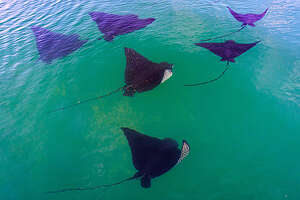 Spotted Eagle RaysDuring the snorkeling session later this morning, which I skipped because I still wasn’t feeling great, Herb saw and photographed lots of Sea Turtles.
Spotted Eagle RaysDuring the snorkeling session later this morning, which I skipped because I still wasn’t feeling great, Herb saw and photographed lots of Sea Turtles.
I looked up the difference between turtle and tortoise and found the following: Tortoises spend most of their time on land, while turtles are adapted for life spent in water. As a result, tortoises have more rounded and domed shells, while turtles have thinner, more water-dynamic ones.
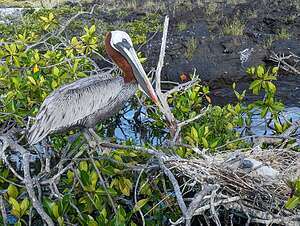 Pelican with her two babiesLater that afternoon, we went for a panga ride to Punta Moreno and entered a grove of mangroves, where blue herons and penguins are often seen.
Pelican with her two babiesLater that afternoon, we went for a panga ride to Punta Moreno and entered a grove of mangroves, where blue herons and penguins are often seen.
But first, we spent our time trying to get closer to the schools of rays we saw in the water.
Tui and Monica were very excited when we came near a school of Cow-Nosed Rays swimming along the surface, where we could get a look at them. They are also called golden rays because of their mustard color, and their noses do actually look like those of a cow.
We also saw a school of beautiful Spotted Eagle Rays, named for their spots When two of them flapped their wing-like fins above the surface, we were able to better see their white spots against their black coloring.
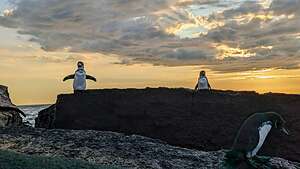 Penguin with flippers outThe birdlife in the mangroves was wonderful as well. We saw a pelican mom with two baby chicks in her nest. I took a video of them also, with them loudly squawking away, and mom somewhat indifferently ignoring them.
Penguin with flippers outThe birdlife in the mangroves was wonderful as well. We saw a pelican mom with two baby chicks in her nest. I took a video of them also, with them loudly squawking away, and mom somewhat indifferently ignoring them.
There were beautiful blue herons nesting in the mangroves. Their necks are so long and thin that I can't imagine how a fish fits down there.
As we left the mangroves, we came around a rocky islet where penguins and flightless cormorants hung out.
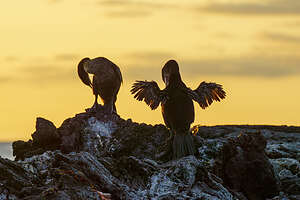 Flightless cormorant drying his wingsI love the penguin cooling himself off by holding his flippers out, but the dejected one heading right out of the photo stole my heart
Flightless cormorant drying his wingsI love the penguin cooling himself off by holding his flippers out, but the dejected one heading right out of the photo stole my heart
It looked like the flightless cormorants were getting ready to settle down for the night as well, but first a little wing drying. Their wings don’t produce enough oil to waterproof them, so that’s why you often see them holding the short stunted wings out to dry.
They looked beautiful silhouetted against the sunset.
I hate to keep repeating myself, but what another incredible day.
Recap of wildlife we saw today: Galapagos giant tortoises, land iguanas, sea turtles, cow-nosed rays, spotted eagle rays flightless cormorants, penguins, pelicans, and blue herons
- ‹ previous
- 8 of 13
- next ›
Galapagos - Isabela Island (Day 3) location map in "high definition"
Javascript is required to view this map.
